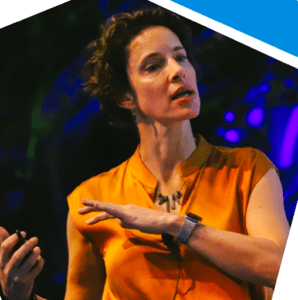2020 was a double-whammy year for diversity, equity and inclusion training: First, there was the forced shift away from in-person to digital learning methods caused by the pandemic, followed by a heated spotlight on DEI issues due to broader social awareness of current events.
We asked five DEI learning leaders how they think 2020 went overall. What trends did they see in DEI corporate training? How big a piece of the puzzle is training anyway, when it comes down to it? Are corporations where these conversations really should be happening in the first place? How do you get learners to come to DEI programs with an open mind?
We also asked these leaders about their thoughts on the future: the pros and cons of online versus in-person DEI learning experiences, advice for corporate efforts in 2021 and beyond, and their own personal take on the “hopeful or frustrated” question at this moment.
Here’s what they had to say.
 Elmer Dixon, president of Executive Diversity Services, longtime human rights activist and co-founder of the Seattle Black Panther party
Elmer Dixon, president of Executive Diversity Services, longtime human rights activist and co-founder of the Seattle Black Panther party
On the importance, or not, of training for DEI success:
I always tell my potential clients that training is not the catch-all. If you want to use it as a band-aid, the band-aid’s going to come off. The root of challenges in most organizations is deeper than most people realize. Most trainers treat the surface. If you’re approaching it properly, you’re developing a DEI strategic plan so that it will go away, so that it becomes ingrained in the organization’s strategic plan and doesn’t have to be called out as a separate thing by itself. But that takes commitment throughout the organization, including executive level commitment. Real diversity at a corporation is a long-term strategy and a process, and training is only part of the solution. Everybody needs the base DEI content and training, but as a leader, it’s incumbent to model inclusive behavior. They have to actually exhibit the behavior for the rest of the organization if they expect the rest of the organization to come along. Where the rubber really meets the road is at that next level down — the directors — because they’re the ones that are going to be in the position of being seen and experienced, employees will experience how they treat others. If it happens at that director level, it begins to sink into the rest of the organization.
On getting open minds to come to the table (or tablet):
We try to get the mindset right with pre-class communications, get the mind open before they come in; but most of that real hard work is going to happen in the classroom. A couple things we’ve found to be critical — every DEI training should have a business component. When they understand the importance of it, we have them build a business case for it and some best practices. Because the business case positions the effort going forward, why are we doing this? You need to answer that question for everyone before they come to training and then hear it again. This is why this is important to this organization. Of course, companies want to do diversity and inclusion because it’s the right thing to do, but how are you going to position it so people really hear it? That’s where the business case comes in. It’s better from a business success perspective to call it something like, “Leveraging differences so we can be more competitive,” rather than “diversity training.”
On 2020 as watershed moment, or passing fancy:
When I began this journey, first as a revolutionary in 1968, we used to say ‘Revolution in our lifetime.’ We believed we would most likely die fighting before that happened. Later as a diversity consultant in 1988, naively I admit, I thought we, in our industry, would train everyone, and by the millennium we’ll be done. Well, we’re in 2021 and we’re still just scratching the surface. I know I won’t see the change I want to see happen in my lifetime, however, I am most encouraged and elated when I get to speak to second and third graders about the BPP legacy, they’re the ones who are going to shift this world. I’m always humbled when asked to speak to them. They give me hope; I definitely have a hope for a better future. I am just blown away by youth of all ages [and] their excitement and enthusiasm when I talk to them. I am certain that eventually we’re going to see a shift. What we saw last summer with the demonstrations was a new beginning of a shift. To see so much fervor over the need to do something different — I look forward to seeing the fruits of that labor.
 Takiyah Gross-Foote, head of global learning, Kimberly-Clark
Takiyah Gross-Foote, head of global learning, Kimberly-Clark
On in-person versus online for DEI
The hardest part of doing DEI online versus in-person is that with this kind of training, you are trying to drive people to act. You want the learning to activate something in them. You have to work hard to make the online learning compelling. But one unintended consequence of going all-virtual last year was that it has, in many ways, given people more courage. When we did our first wave of VILT in 2020, we had to extend session times because people were sharing so much, and I wonder if there would have been so many stories told in a traditional face-to-face session. I think people feel more free to share online, and through that sharing they are going to learn. Face-to-face versus online is a broader question than just DEI. The workforce of the future has changed in terms of remote work and working from home. I don’t think there will ever be a time again when we’ll be in the office full-time. I think it will be partial or stay fully remote.
The parallel to that is that learning will forever be changed by 2020 because so many people pivoted to digital for topics that they never would have considered for digital consumption. That doesn’t mean that it will all stay digital — definitely we will see more blended approaches — but I think digital is here to stay. The reason why is because of speed and scale. Companies are going to realize, if they haven’t already, that when they want to scale something quickly, globally [and] to many employees, digital will allow them to do that. But when scaling and moving faster and broader, you need it to be as effective as possible and that’s where you can leverage additional supporting modalities in addition to the digital components. The strengths of the different modalities – online, in person, virtual — depend on the outcomes you’re trying to drive. Digitally we can push a lot of content, and with collaborative online learning we can push content and context, but where other modalities pair nicely are when we need to apply more points of application or practice. It’s about outcomes, and the content makes a difference. I’m not going to just get good at it by watching someone coach. I have to practice coaching and have scenarios where I have to coach to that scenario. That’s where looking at the content and outcomes helps you decide on the blend of modalities to make sure the learning sticks.
On the importance, or not, of training for DEI success
Training is a huge catalyst, that’s invisible in a sense. Training can be a foundation of people understanding what DEI is and why it matters. When an organization can get employees to see DEI more broadly and actively behave in a way that supports it, it’s the training that starts the journey. It goes hand in hand with other things — you still need the leadership sponsorship and supportive performance objectives — but the education part plays a critical role in helping people see what’s possible. There needs to be company context built into every section of a DEI learning experience, so people can see themselves in the journey and understand why it’s important to the business.
On using events in the news in training programs
We have not used a lot of the news as a source of our training lessons because we’re leading with the I and not the D, and we’re defining diversity as a broader issue. When we shared our DEI content with our leaders around the globe, we purposefully pulled out all the very U.S.-centric examples like George Floyd, assuming it wouldn’t resonate elsewhere. But the feedback we got was, “You should really add a video in about George Floyd.” The rest of the world is watching us, and watching to see what we do in reaction to these 2020 events.
On the future of DEI in corporations
This is our time as learning leaders to be as creative as possible and really push the envelope on how we drive learning in the organization. I would encourage us as learning leaders to unlearn some things. We have to be intentional about the outcomes we’re trying to drive and the learner experience has to be at the top of that list, and we can’t forget that. Creativity and innovation is long overdue in our space, and it’s time for us to embrace it. I am much more optimistic than not about the future. I’m definitely hopeful that we can use this shift to not only open the door to more digital experience, but more creativity in how we push learning to employees, period. It’s also an opportunity for us to use this moment to get the investments we need in order to support the way we want to implement training in the future. Now, there’s a burning platform for it in many cases. Skills acquisition and skill development are so paramount to the future. This is our time to step up and say, we can create new ways of learning, and we can help equip the organization with skills of the future.
 Marin Heiskell, manager, human capital, DE&I practice, Deloitte
Marin Heiskell, manager, human capital, DE&I practice, Deloitte
On trends in 2020
2020 was threefold as far as trends. A lot of clients were starting to do listening sessions, particularly about the experience of Black employees and how they show up, or feel that they can’t show up. Executives and real leaders who can drive real impact were starting to attend — many of them for the first time. The second trend was that a lot of learning opportunities arose, especially around bias, what inclusion is and is not, inclusive leadership, etc. Third was corporations actually having a DEI strategy, not just an initiative, program or talent recruiting piece, but a thorough end-to-end DEI strategy embedded in their business strategy. Another trend we’re seeing is people not traditionally connected with DEI coming to the table, like finance leaders or engineering section heads who might not have felt a connection with DEI initiatives in the past, saying, “Can you help us? We have very unique needs, particularly STEM functions.”
On measuring progress
There are common pitfalls to DEI that we saw a lot in 2020. Even if you have a very robust strategy, there can be things hampering it. Are you capturing complete data? Incomplete or inaccurate data can be detrimental. Is it siloed as part of HR or embedded as part of the overall strategy? Is the DEI lead a part-time gig? Sometimes it’s the pressure of women and people in color to sponsor everything: If you’re the woman who’s made it to the C-suite, you wind up sponsoring every women’s initiative in the company, which both overwhelms you, and doesn’t bring along other people in the company as allies. And it also doesn’t send a message of leadership alignment. Those are some of the pitfalls we see and check for when helping clients. A huge part of measuring the impact of DE&I learning is employee engagement scores. But pay attention to how you are looking at the scores: Are they looking at the data by gender? Race? Tenure? Function? Is it getting broken down correctly? Oftentimes the measurement is also overlapped with business performance in itself, so you should pay attention to the customer segments you’re attracting. In this market, consumers are really paying attention and spending their money on companies whose insides reflect their outsides. The use of benefits can also really say how engaged an employee is with an employer. Are your under-represented groups taking advantage of all of the benefits you provide? Those are just a few. The metrics are often there, they’re just not being mapped to DEI targets.
On the importance, or not, of training for DEI success
I have very mixed feelings about training’s part in overall DEI. Training’s important but what is most impactful is being engaging. Try to minimize lecturing and how much you are talking, make it almost a lab experience for the learners. What makes me cringe is when DEI learning is not a DEI strategy. Training is not a strategy. Training can pave the way for strategy, but that’s not the same thing. Training is, however, really really important for alignment. One of the things that I’m seeing happen and am happy about is a lot of DEI training is becoming “unspoken mandatory” training. Completing it is a part of your year-end performance management. Not to hammer certain ideals down someone’s throat, but just to make sure there’s clarity around definitions and what an organization’s vision and mission is around diversity and inclusion. What we really need to work on is bringing people along on the journey when they’re not as far along in a way that they feel included and valued, asking questions, etc. Conservative voices also need to be welcome at the table. If training is mandatory, make it clear it’s mandatory for everyone so it doesn’t feel like people are being singled out. Then, be careful of highly politicized and polarizing terms. Make it about conversation, about our company’s definition and stance on this part of DEI, or that part.
On whether or not this type of training even belongs in the workplace
A lot of people will say “Why are we talking about this at work?” It’s about connecting those dots back to the business. There’s a way to connect to business outcomes without completely removing the individual. Corporations are expecting more of us now. We have no work-life balance, but work-life integration, from the demands expected of us to the benefits like gym memberships or pet insurance. It’s becoming harder to compartmentalize, which makes the DEI conversation at work that much more important. I wish it didn’t have to happen at work – in a dream world, my job wouldn’t exist. But unfortunately, not everybody is having conversations about this in their homes. So it has to happen at work right now, but it has to be anchored in the business’s values and vision.
On in-person versus online for DEI
Often when we’re sitting at our workspace at home doing online learning, there can be a certain comfort level. The hierarchy is different when people are humanized on video from their homes. You relax when you see a senior leader’s kid come tap them on the shoulder or hear their dog bark because they’ve become so much more relatable. Some walls are automatically down with digital learning. However, oftentimes when we are all in a room together — it’s like the difference between practicing yoga at home and doing it in a group in a studio — something about the ambience can create a different level of impact.
You also have to be aware of who you are and are not reaching with digital learning. Retail customer-facing employees aren’t sitting at their laptops all day, but they might even need DEI learning more because they’re your company’s face to the world. You need to think creatively about getting learning to people — that is going to be a big next step in DEI training. It may or may not be in-person. That’s a big open question right now. How do you go in and teach DEI in a way that addresses the unique culture and tools available of different business units? More traditional things like posters in the break room might still play a role in many companies or sections of companies. The way that DEI challenges show up at a distribution center is probably different from the way it shows up at corporate headquarters. So, how do you keep the same DEI values that you want everyone at the company to know, and develop the same level of understanding in someone who’s a market analyst, versus a greeter at a store, versus someone on the conveyor belt at the warehouse?
On 2020 as a “moment”
I relate the George Floyd moment to the Civil Rights movement, when, for the first time, the cameras caught the fire hoses being turned on the marchers. Watershed moment, right? It had been happening for a long time! But now it was on the international news. It was the same thing with George Floyd, but this time it was a cell phone. It brought people along on their DEI journey from wherever they were, and forced the conversation in a very different way. I’m somewhere between hopeful and frustrated right now. I was reminded by Martin Luther King Jr. Day, that when [King] was assassinated, he was one of the top five most-hated men in the U.S. And look at what has happened in just one generation. A lot of my points of frustration are balanced out. I do think there are a group of people who will find, in a generation, [that] they’re on the wrong side of history. But if we are consistent with our message, our approach and with embracing people wherever they are on their journey, that is what’s going to get us to rise to the occasion at this moment in history.
 Lisa Rock, co-founder and chief innovation officer, NeuroLeadership Institute
Lisa Rock, co-founder and chief innovation officer, NeuroLeadership Institute
On trends in 2020
The thing that surprised me over the last year is the wave of organizations coming to us with no idea what to do, saying “Give us anything. Help.” The first thing is to decide what it is that you want because we’re not here to change society, we’re here to change the culture in your organization in a specific way. We can’t change people’s beliefs, but we can give them tools to do what they specifically want to do within an organization. For example, your company could focus on how to get people to notice that they’re biased, or they could be focused on your employees getting heard, or maybe how to hire people who don’t look like the majority in our company.
On 2020 as watershed moment, or not
It’s too soon to tell if 2020 was a watershed moment. I think there has been good lip service, good shifts in the conversation happening – but let’s face it, this is a really uncomfortable conversation and it’s really easy to get wrong. For instance, I could say something that is perceived as inappropriate here in this article and get called out for it, but that leads to another conversation. Lots of organizations are doing really well and employees are really holding their employers to account, but the jury’s out on 2020 still. Some corporations have been doing tremendous work over years in policies that are supportive of diversity and other significant policy shifts, and some of that has been invisible to the broader population — until something brings it to the fore, as happened last year. Companies are now trying to have on their sleeve their DEI policies and charitable initiatives. The good news is that large organizations are made up of employees, individuals. So, raising the issues, speaking to HR and educating them if they’re not aware are things individuals can do. This is a great time to lobby managers and directors because there’s a broad social movement. If you’re a champion at a leader level, raise questions such as: Are we getting all the possible perspectives into this decision-making process? How do we make this a better decision? Decisions are better — everything is better — when you get more diverse inputs in the room. Calling out for that in meetings [is] the most relevant thing a leader in an organization can do. If we all look the same in a meeting, can we raise that question? Are we servicing the greater good here? Are there other perspectives we can bring in today?
On the importance, or not, of training for DEI success
When we’re faced with something we don’t know how to do, it’s really great to be given skills, practice, a safe space to do it poorly, if you will. Training and having conversations is an essential component for shifting culture. It’s not enough in some cases, but it’s an essential component. You need skills that will help people call out bias or be more inclusive in meetings, in addition to policies and leadership. One of the major problems we have in this realm is that companies mandate diversity training, and that’s always a really negative outcome for any training, let alone DEI training. People have to be curious to have a good mindset, and leaders have to role-model. So, how do you change the hearts and minds of the leaders to support and endorse the training? It’s about having a clear why: why the training, why we want you to change your behavior. Whether the outcome is a more successful company, a more equitable workforce, the benefits for innovation — there are so many components possible, so you have to determine why this company is on the DEI journey.
On face-to-face versus virtual
You can’t compress DEI training into a day. You have to have it in small pieces. It’s about giving people time to reflect, become aware of their own habits, having that awareness go into their real workflow and then coming back online to the course and taking that experience apart; what they did at work that week, what they noticed, and then reflecting. I know that a lot of companies do live training for relationship-building, but in terms of pure learning, distributed and virtual can get a much better outcome. A lot of companies will have come to that insight and will continue to do a significant amount of virtual training moving forward.
On measuring progress
The thing that everyone wants is to know how we know it’s working. It’s difficult because the environment is so noisy — multiple training, policy shifts, restructuring — so it’s really hard to isolate. What we measure is how much of the key concepts a learner remembers, how often have they been applying them in meetings and how their direct reports’ behavior changed. We’ll unpack it from multiple ways. We can say pretty solidly that we can achieve pretty significant shifts in a two- to three- to five-year timeline. That’s a solid commitment. But to make it automatic and ensure your strategies, communications, policies, systems and training are aligned — that’s a long journey.
On hope versus frustration
It is a deeply frustrating and frightening moment that we have not, as a society, looked after our community in the U.S. The next pandemic is not going to be stopped at a border, so we need to look after everybody, not just ourselves. And we need to shift that. I don’t know how to shift societally, but what’s incredibly hopeful is the amount of innovation and changes that have happened in a very short time that we couldn’t have imagined — the products to market timeline, the new products, the products shifting to online — so many innovations have happened that hopefully will free us up to think in new and different ways as we look forward from here. I’m not hopeless, I’m just concerned about diversity and how that’s playing out now.
 Rashada Whitehead, head of colleague experience, people & community, Grant Thornton
Rashada Whitehead, head of colleague experience, people & community, Grant Thornton
On the importance, or not, of training for DEI success
I would put training into a couple of buckets. Training is a huge part of what we’re doing because if the technical knowledge is not there, the practical application of new ideas is much slower to come along. But training is important even when we don’t call it training. It gets embedded into processes and systems. Provide an opportunity for alignment and universal understanding, and start with unconscious bias training, then move to topics like psychological safety or microaggressions, so that everyone’s working from the same baseline. Embed DEI concepts in new processes, procedures and structures within the organization. We even join tax and audit training, and embed some DEI resources within there. That’s how it gets to be in the company’s bloodstream — it has to be embedded into everything. You want people to walk on from a DEI training experience knowing “That was for me, that was for us.” Me as an individual, and us as a company. You can’t forget the person who’s most skeptical and wants no part of this. They need to also know, what’s in it for them? That’s a process, that’s work, to check ourselves and filter ourselves. It requires agility and constant scrutiny to keep yourself as an organization honest.
On measuring progress
Who’s going to best be able to tell you that an organization is winning on belonging [won’t] be me in the office of DE&I – it’ll be my thousands of colleagues across the firm. I can speak to our strategy and my experience but overall, whether or not we’re moving the needle, there is a whole army of voices who play into it. Transparency is bigger than just sharing DEI data. It’s not an event, transparency is a process. As we think about going forward in 2021, it’s a two-way street. As much as we can share out, we have to take the feedback that’s not always going to be positive or something we thought about. I would encourage organizations to have their ear to the street, as I like to call it. Sometimes your best thinking comes from there. Then you make sure those things fit into your overall business strategy. The more people open broader conversations, the more you start seeding listening pods or town halls, the more you open up at every level and talk it out — when you start doing things like that, you start activating accountability. From there, you start to define your aligning north star: where is your unity and intersectionality. You might not be able to solve all of the challenges you hear about, but you can take two or three things your organization can do well and start there with the low-hanging fruit that might drive toward bigger challenges.
On best practice advice
My two main pieces of advice for companies just getting started on their official DEI journey is to be slow and steady, and consistent. Slow and steady — this goes back to being authentic and acknowledging where you are. Have those candid conversations. You can also challenge yourself to push forward, but you can’t game the system on where you are. If you are ten steps out ahead of your people and they haven’t heard anything about it before, it’s going to be an impractical leap for behavior change — especially if we didn’t have the same basic understanding in the first place. Consistency comes in because we don’t have as much of a heat lamp on DEI topics as we did last summer, but we stood up and spoke as a company then, and people will hold you to account if you let things slide off the table. If it becomes a one-and-done tactic to match a certain period in time and you don’t keep it consistent in years to come, your employees will notice. My other top piece of advice is to be OK with marketing. That might sound strange, but think about good old-fashioned advertising—what you talk about or promote is what people adopt or buy. People will come in with a heightened sense of awareness if you’re talking about it. There will be a natural uptick because people can see where the company is putting their resources. Be OK with talking about things that you are investing in. It doesn’t have to be braggy or showy, but you do need visibility to continue to build trust and credibility.
On in-person versus face-to-face
We’ve seen great participation rates for voluntary programs. With in-person training you have to budget for physical space, but if you estimate 1,000 people for a virtual training and 3,000 show up, you can handle it and open it to all those people, pending licensing. It really extends that opportunity. We might do a hybrid digital and live approach to DE&I training in the future because there’s something about a spirit of belonging that has a high-touch value to it. But because it worked so well in 2020, we can stay virtual if we need to and expand back into live in-person elements later.
On the future
I am super hopeful about the future. Super hopeful. If I think about my own life and history I’ve studied, sometimes the worst of times and the best of times are more closely aligned than we think. One of the most challenging years of my life was last year. Nobody made it out unscathed if you were human, no matter what your perspective, you were touched. Looking back in hindsight, it was necessary. Now, in the moment, it was “I can’t believe this is happening,” and “why are we here,” but in hindsight, it’s a setup for growth and progress for both individuals and from a company perspective.















